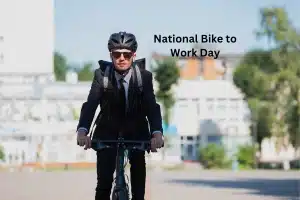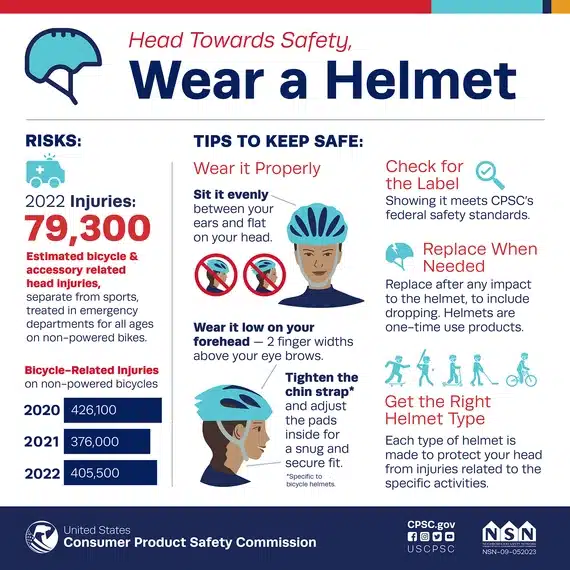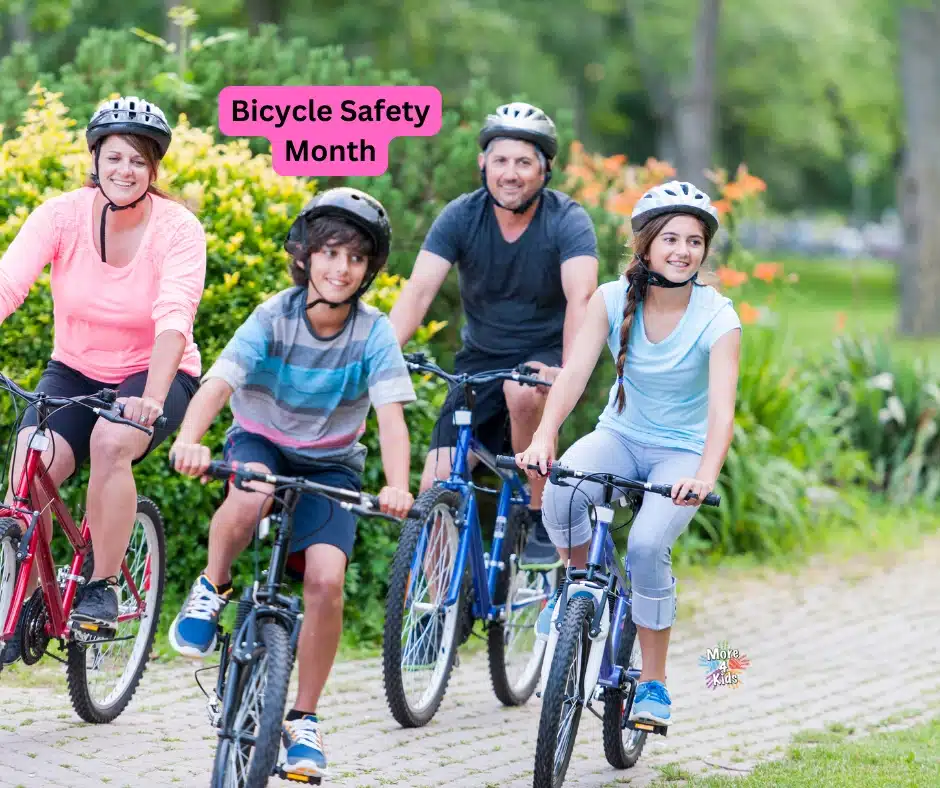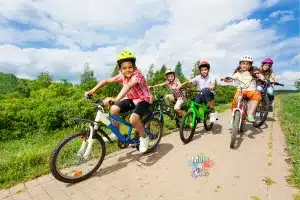May 19th is Bike to Work Day. It also happens to be National Bike Safety Month as well. While there are many benefits of cycling to work, bike safety is an important part of the conversation and important for our children. Let’s explore the benefits of using your bicycle to commute, while keeping yourself and family safe.
Bike to Work Day
Table of Contents

Some of the benefits from biking to work are:
Improved mood:
Exercise increases both dopamine and serotonin release, which are known to improve mood. Regular participation in exercise can help reduce stress, anxiety and depression.
The right kind of stress actually makes our bodies more resilient. Exercise improves cardiovascular function, along with keeping muscles strong. Cycling to work helps you get your workout in for the day.
- Save Money:
Between rising gas costs, parking fees and public transportation tickets, getting to work can be expensive. Biking to work (even just a couple days a week) can help you reduce commuting expenses.
- Reduce carbon footprint:
An average person commuting to work emits about 4.6 metric tons of carbon dioxide per year. Choosing a bike just once a day can help reduce a person’s carbon footprint by 67%. With the effects of global warming visible all around, biking to work is an easy way to help the environment.
Bike Safety Month
The month of May is Bike Safety Month. Sharing the road can be difficult, as cyclists are smaller and less visible to drivers. Bike riders should practice defensive techniques like using hand signals, maintaining a safe distance from cars, staying visible, and avoiding blind spots. Riders should choose bike-friendly routes and use bike lanes whenever available. In 2022, there were over 400,000 bicycle related injuries.
Why I Always Wear a Bike Helmet
When I was 10 years-old, a bicycle meant freedom. We rode bikes everywhere, to school, to the park, to friends houses and occasionally, to the grocery store to buy penny candy and rent movies. It wasn’t unusual to ride home from school, grab a quick snack, then stay outside riding bikes until dinner. Despite our parents’ rules, wearing helmets was frequently forgotten.
One afternoon, a group of kids in my neighborhood, including my little sister and me, headed out on our bikes. My sister could ride her bike independently, but the bike path we rode on was full of hills, posing a challenge for a 6 year old.
My little sister was making a strong effort to keep up. She got in front of the pack, just as we reached the first downward hill. The natural decline mixed with her advancing speed, led her straight into a fence post. She fell into the grass and laid limp as we all raced towards her.
One child sprinted to the closest house to get help. I threw my bike into the weeds and ran to my sister. She was knocked unconscious and wasn’t breathing. After a rudimentary CPR effort, her belly began moving up and down again, but she was still non-responsive. After what seemed like hours, a team of paramedics arrived. I can still clearly picture them carrying my sister away on a stretcher.
While my sister came away with no memory of the accident, a concussion and a fractured thumb, I received a great life lesson. Witnessing what could’ve been a fatal incident, gave me a deep respect for bike helmets and bike safety. I hope to encourage you to use your bike when traveling to work or as a leisure activity, while putting safety first.
Helmets Are Effective
Bike helmets may seem like an inconvenience, however they can protect against traumatic injury. This study found that helmets provide a 63–88% reduction in the risk of head, brain and severe brain injury for all ages of bicyclists. Even in crashes involving motor vehicles, helmets were found to provide the same levels of protection at 69%. Helmets also help reduce injuries to the upper and mid facial areas by 65%.
How to Wear a Helmet Correctly
Proper protection against head and brain injuries, requires helmets to be worn correctly. In 2022, there were 79,300 bicycle and accessory related head injuries in ER departments. Because helmets come in a variety of sizes and styles, it’s important to know how to put one on. Here are things to know about wearing a helmet properly:
- Get the right type of helmet for your activity.
- Wear the helmet low on your forehead, two finger widths above your eyebrows.
- Sit it evenly between your ears and flat on your head.
- Tighten chin strap for snug fit.
- Replace after any impact, including dropping.
- Check the label to ensure it meets CPSC’s standards.
Bike Safety and Kids: Vital Knowledge for Our Young Riders
One crucial aspect of bike safety is educating our young ones. After all, our kids are the future generation of cyclists. Understanding and implementing bicycle safety from an early age could foster a lifetime of safe riding habits.
 Start Early: Teaching Kids About Bike Safety
Start Early: Teaching Kids About Bike Safety
Let’s not forget that for many children, their first bicycle is more than just a toy. It’s a rite of passage, a ticket to independence, and the first step towards a healthier lifestyle. But with all these benefits, there are responsibilities, too. Teaching children about bicycle safety should start as early as when they first start riding, ensuring they grow up to be responsible, safe cyclists.
Children should be taught to:
- Always wear a helmet and make sure it’s worn correctly.
- Observe traffic rules, such as riding on the right-hand side and stopping at stop signs.
- Use hand signals when turning.
- Avoid riding at night. If it’s necessary, ensure they have reflective clothing and working bike lights.
- Regularly check their bike for any maintenance needs.
Why Helmets Matter for Kids
In many kids sports proper protection is vital. Bicycling is no exception. Children’s heads are proportionately larger than their bodies compared to adults, making them more susceptible to head injuries. Hence, wearing a helmet is even more vital for them. Moreover, kids tend to be more impulsive and less aware of their surroundings, making the risk of accidents higher.
Helmets for kids should fit properly, meaning it should be snug but comfortable, sitting level on the head and low on the forehead, one or two finger-widths above the eyebrows. Remember, safety should never be compromised for style when it comes to children’s helmets.
Safe Riding Environments for Kids
Children under ten should preferably ride their bikes on sidewalks, bike paths, or parks rather than the street. At this age, they might not have developed the necessary skills to navigate roads with traffic safely. However, this varies by location as some local laws or regulations might not allow sidewalk riding.
Also, parents and guardians can practice safe riding with their children in different environments, which can include going over what to do at intersections or how to watch out for cars reversing out of driveways.
Role Model for Safety
As parents, guardians, and adults, it’s crucial that we model proper bicycle safety behavior. Children learn by watching us, and when they see us wearing helmets, observing traffic rules, and using hand signals, they are more likely to do the same.
Bike to Work Day and Bike Safety Month are not only opportunities for adults to be more environmentally conscious and physically active but also a perfect time to teach the younger generation the importance of bike safety. It’s a gift of knowledge that they’ll carry with them every time they pedal, giving you peace of mind knowing that they’re taking the right precautions. The more we embrace bike safety and instill it in our children, the safer our roads will become for cyclists of all ages.
Conclusion
Bike Safety Month doesn’t stop with helmets. Additional safety equipment may include elbow and knee pads, glasses or goggles, headlights, illuminated vests, and reflective clothing. Select safety gear that will protect your body as well as increase your visibility when riding.
Bike to Work Day and Bike Safety Month are great to encourage family, friends and colleagues to trade in four wheels for two. Employing proper safety equipment, defense biking techniques, and sharing the road will help develop a safety-first approach while embracing the benefits of biking to work.
FAQ
How do I teach my child to ride safely?
You can begin by teaching them the basics, like wearing a helmet, observing traffic rules, using hand signals, and checking their bike before riding. Practice riding with them in safe environments like parks or bike paths.
What size helmet does my child need?
A child’s helmet should fit properly—it should be snug but comfortable, sit level on the head, and low on the forehead. Measure your child’s head circumference for accurate sizing.
Where can I find bicycle safety resources for children?
You can check websites like Safe Kids Worldwide or The National Highway Traffic Safety Administration for bicycle safety resources targeted at children.
Where can I learn more about Bike to Work Day and Bike Safety Month?
You can visit the League of American Bicyclists to find more about their organization. They offer education and events to further their mission.
How do I ensure my helmet meets the CPSC’s standards?
All bicycle helmets should come with a label that shows they meet the standard. You can find more about the testing and requirements of manufacturers on their website.
How do I find bike friendly routes to take?
There are many ways to find bike friendly routes. Try searching the internet for “your city + bike routes”. Google Maps also has a bike lane feature you can turn on. There are third-party apps like BikeMap that can also help.









 Start Early: Teaching Kids About Bike Safety
Start Early: Teaching Kids About Bike Safety




Add Comment